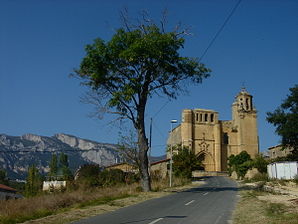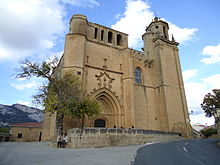Leza
| Municipality of Leza / Lezako | ||
|---|---|---|
 Leza - town view
|
||
| coat of arms | Map of Spain | |

|
|
|
| Basic data | ||
| Autonomous Community : |
|
|
| Province : | Álava | |
| Comarca : | Cuadrilla de Laguardia-Rioja Alavesa | |
| Coordinates | 42 ° 34 ′ N , 2 ° 38 ′ W | |
| Height : | 569 msnm | |
| Area : | 9.92 km² | |
| Residents : | 203 (Jan. 1, 2019) | |
| Population density : | 20.46 inhabitants / km² | |
| Postal code : | 01309 | |
| Municipality number ( INE ): | 01034 | |
| administration | ||
| Website : | Leza / Lezako | |
Leza ( Basque : Lezako ) is a place and a municipality ( municipio ) with 203 inhabitants (as of January 1, 2019) in the province of Álava in the Autonomous Community of Basque Country in northern Spain . The place belongs to the wine-growing region Rioja Alavesa .
Location and climate
The place Leza is located at an altitude of about 570 m in the southwest of the province of Álava near the border with the autonomous community of La Rioja . The closest major city is Logroño , about 25 km (by car) to the southeast ; the lovely small town of Laguardia , to which Leza belonged until the 17th century, is located a good 5 km southeast. The climate is temperate to warm; Rain (approx. 635 mm / year) falls mainly in the winter half-year.
Population development
| year | 1857 | 1900 | 1950 | 2000 | 2018 |
| Residents | 493 | 461 | 400 | 208 | 196 |
The phylloxera crisis in viticulture, the mechanization of agriculture and the resulting loss of jobs have led to a continuous decline in the number of inhabitants since the middle of the 20th century.
economy
In the early centuries, the self-sufficient residents lived mainly from the agricultural products of the surrounding area, including wine. The place itself, located at the intersection of several paths, functioned as a market and trade center, but craftsmen also settled here. A lung sanatorium was built in the 1930s . The increasing importance of viticulture and wine tourism in the Rioja Alavesa has had a positive effect on employment again in recent decades.
history
Two large stone graves ( dolmens ) testify to the presence of people in the 4th millennium BC. Chr .; Celts , Romans , Visigoths and Moors , on the other hand - despite the proximity to the Ebro Valley - left no archaeologically usable traces on the municipal area. The place probably first arose in the course of recapturing ( reconquista ) and resettlement ( repoblación ) of the occupied territories from the Moors in the 10th and 11th centuries. The place is mentioned for the first time under the medieval spelling Leça in the 10th century; in 1666 the Spanish King Charles II granted him city rights .
Attractions
- The parish church (Iglesia de San Martín) is an imposing building made of precisely hewn stones from the 16th to 18th centuries. The west facade is completely unadorned; the late Gothic portal on the south side closes with a basket arch ; in the tympanum above there is an equestrian statue of St. Martin . Above the portal zone there is a kind of walkway with arched openings from which there is a good overview of the surrounding area. The bell tower ( campanar ), which is square below but octagonal above, is also on the south side at the end of the single nave nave; the apse is broken polygonally. A certain defensive character cannot be denied to the building.
- Surroundings
- The two megalithic passage graves (Layaza and El Sotillo) belong to the Ruta de los dólmenes ; However, they are poorly preserved - the cap stones are completely missing.
Web links
- Leza - photos + info (spanish)
Individual evidence
- ↑ Cifras oficiales de población resultantes de la revisión del Padrón municipal a 1 de enero . Population statistics from the Instituto Nacional de Estadística (population update).
- ↑ Leza - climate tables
- ↑ Leza - population development

